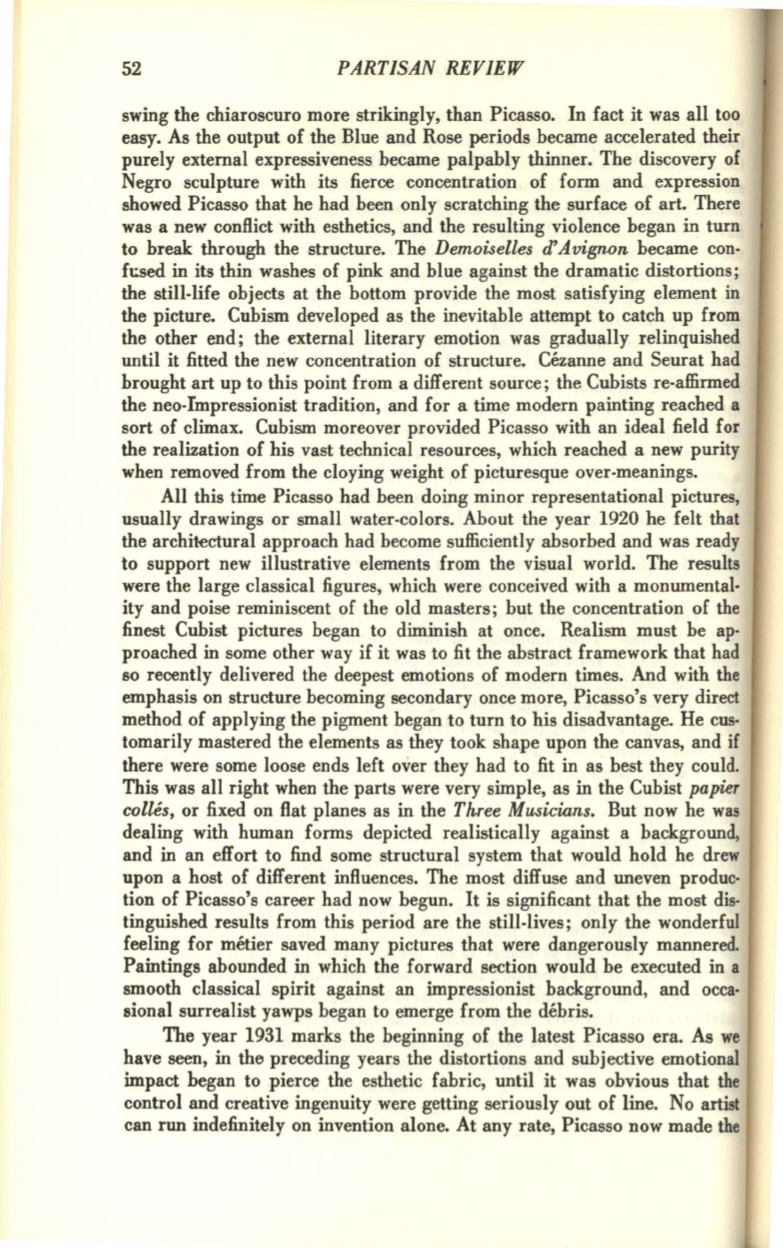
52
PARTISAN REVIEW
swing the chiaroscuro more strikingly, than Picasso. In fact it was all too
easy. As the output of the Blue and Rose periods became accelerated their
purely external expressiveness became palpably thinner. The discovery of
Negro sculpture with its fierce concentration of form and expression
showed Picasso that he had been only scratching the surface of art. There
was a new conflict with esthetics, and the resulting violence began in turn
to break through the structure. The
Demoiselles d'A
vigTWn
became con·
f&sed in its thin washes of pink and blue against the dramatic distortions;
the still-life objects at the bottom provide the most satisfying element
in
the picture. Cubism developed as the inevitable attempt to catch up from
the other end; the external literary emotion was gradually relinquished
until it fitted the new concentration of structure. Cezanne and Seurat had
brought art up to this point from a different source; the Cubists re-affirmed
the neo-Impressionist tradition, and for a time modern painting reached a
sort of climax. Cubism moreover provided Picasso with an ideal field for
the realization of his vast technical resources, which reached a new purity
when removed from the cloying weight of picturesque over-meanings.
All this time Picasso had been doing minor representational pictures,
usually drawings or small water-colors. About the year 1920 he felt that
the architectural approach had become sufficiently absorbed and was ready
to support new illustrative elements from the visual world. The results
were the large classical figures, which were conceived with a monumental·
ity and poise reminiscent of the old masters; but the concentration of the
finest Cubist pictures began to diminish at once. Realism must be ap·
proached in some other way if it was to fit the abstract framework that had
so recently delivered the deepest emotions of modern times. And with the
emphasis on structure becoming secondary once more, Picasso's very direct
method of applying the pigment began to turn to his disadvantage. He cus·
tomarily mastered the elements as they took shape upon the canvas, and
if
there were some loose ends left over they had to fit in as best they could.
This was all right when the parts were very simple, as in the Cubist
papier
colles,
or fixed on flat planes as in the
Three Musicians.
But now he was
dealing with human forms depicted realistically against a background,
and in an effort to find some structural system that would hold he drew
upon a host of different influences. The most diffuse and uneven produc·
tion of Picasso's career had now begun. It is significant that the most dis·
tinguished results from this period are the still-lives; only the wonderful
feeling for metier saved many pictures that were dangerously mannered.
Paintings abounded in which the forward section would be executed in a
smooth classical spirit against an impressionist background, and occa·
sional surrealist yawps began to emerge from the debris.
The year 1931 marks the beginning of the latest Picasso era. As we
have seen, in the preceding years the distortions and subjective emotional
impact began to pierce the esthetic fabric, until it was obvious that the
control and creative ingenuity were getting seriously out of line. No artist
can run indefinitely on invention alone. At any rate, Picasso now made the


